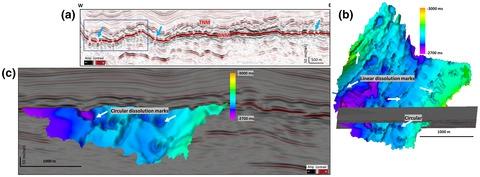当前位置:
X-MOL 学术
›
Basin Res.
›
论文详情
Our official English website, www.x-mol.net, welcomes your feedback! (Note: you will need to create a separate account there.)
Seismic characterization and depositional significance of the Nahr Menashe deposits: Implications for the terminal phases of the Messinian salinity crisis in the north-east Levant Basin, offshore Lebanon
Basin Research ( IF 3.2 ) Pub Date : 2022-07-19 , DOI: 10.1111/bre.12697 S. M. Mainul Kabir 1 , David Iacopini 2 , Adrian Hartley 1 , Vittorio Maselli 3 , Davide Oppo 4
Basin Research ( IF 3.2 ) Pub Date : 2022-07-19 , DOI: 10.1111/bre.12697 S. M. Mainul Kabir 1 , David Iacopini 2 , Adrian Hartley 1 , Vittorio Maselli 3 , Davide Oppo 4
Affiliation

|
Over the last decade, there has been a resurgence of interest in the climatic and tectonic mechanisms that drove the Messinian salinity crisis (MSC) and the associated deposition of thick evaporites. The MSC represents an unprecedented palaeoceanographic change that led to a very short (ca. 640 kyr) ecological and environmental crisis. However, across the Levantine offshore basin, the sedimentological nature of the top evaporitic units and the mechanisms that controlled the transition from a hypersaline evaporitic unit to brackish deposits (final MSC stage 3) are still disputed. Here, we re-evaluate the deposits associated with the terminal phase of the MSC, named in offshore Lebanon as the Nahr Menashe Unit (NMU). We describe the NMU seismic facies, characterize and map its internal seismic stratigraphy and provide a new interpretation of its depositional environment, which persisted during the late Messinian and then evolved through a regional reflooding event. The base of the NMU overlies semicircular depressions, randomly distributed linear marks and surface collapse features, which are indicative of a period of intense evaporite dissolution. The NMU seismic facies observed from the slope to the deep part of the basin support the interpretation of a layered salt-evaporite-sand depositional system subject to complex reworking, dissolution, deposition and final erosion. A drainage network of valleys and complex tributary channels incising into the top NMU shows marked erosional characteristics, which indicate a dominant southwards sediment transfer following deposition of the NMU. The drainage network was subsequently infilled by layered sediments interpreted here to represent the post-MSC marine sediments. Our analysis adds important details regarding previous interpretations of the NMU as fluvial in origin. Specifically, the presence of subcircular, linear dissolution features coupled with mound-like features indicates that the NMU is composed dominantly of evaporites that were subject to dissolution prior to erosion associated with the drainage network. The NMU is interpreted to represent the deposition/redeposition of a mixed evaporite-siliciclastic succession in a shallow marine or lacustrine environment during the tilting of the offshore Lebanese basin.
中文翻译:

Nahr Menashe 矿床的地震特征和沉积意义:对黎巴嫩近海黎凡特盆地东北部墨西拿盐度危机末期的影响
在过去的十年中,人们重新开始关注导致墨西拿盐度危机 (MSC) 以及相关的厚蒸发岩沉积的气候和构造机制。MSC 代表了前所未有的古海洋学变化,导致了非常短的(约 640 kyr)生态和环境危机。然而,在整个黎凡特近海盆地,顶部蒸发单元的沉积学性质以及控制从高盐度蒸发单元向微咸沉积物(最终 MSC 第 3 阶段)转变的机制仍然存在争议。在这里,我们重新评估与 MSC 末期相关的矿床,在黎巴嫩近海命名为 Nahr Menashe Unit (NMU)。我们描述了 NMU 地震相,表征和绘制其内部地震地层学,并为其沉积环境提供新的解释,该沉积环境在晚墨西拿期持续存在,然后通过区域再洪水事件演变。NMU 的底部覆盖着半圆形凹陷、随机分布的线性标记和表面塌陷特征,这些特征表明存在一段强烈的蒸发岩溶解。从盆地斜坡到深部观察到的 NMU 地震相支持对一个经历复杂改造、溶解、沉积和最终侵蚀的层状盐-蒸发岩-砂岩沉积系统的解释。切入 NMU 顶部的山谷和复杂支流河道的排水网络显示出明显的侵蚀特征,这表明在 NMU 沉积后沉积物主要向南转移。排水网络随后被层状沉积物填充,此处解释为代表后 MSC 海洋沉积物。我们的分析增加了关于 NMU 起源于河流的先前解释的重要细节。具体而言,亚圆形、线性溶解特征与土丘状特征的存在表明 NMU 主要由蒸发岩组成,蒸发岩在与排水网络相关的侵蚀之前受到溶解。NMU 被解释为表示黎巴嫩近海盆地倾斜期间浅海或湖泊环境中混合蒸发岩-硅质碎屑岩层序的沉积/再沉积。我们的分析增加了关于 NMU 起源于河流的先前解释的重要细节。具体而言,亚圆形、线性溶解特征与土丘状特征的存在表明 NMU 主要由蒸发岩组成,蒸发岩在与排水网络相关的侵蚀之前受到溶解。NMU 被解释为表示黎巴嫩近海盆地倾斜期间浅海或湖泊环境中混合蒸发岩-硅质碎屑岩层序的沉积/再沉积。我们的分析增加了关于 NMU 起源于河流的先前解释的重要细节。具体而言,亚圆形、线性溶解特征与土丘状特征的存在表明 NMU 主要由蒸发岩组成,蒸发岩在与排水网络相关的侵蚀之前受到溶解。NMU 被解释为表示黎巴嫩近海盆地倾斜期间浅海或湖泊环境中混合蒸发岩-硅质碎屑岩层序的沉积/再沉积。线性溶解特征加上土丘状特征表明 NMU 主要由蒸发岩组成,蒸发岩在与排水网络相关的侵蚀之前受到溶解。NMU 被解释为表示黎巴嫩近海盆地倾斜期间浅海或湖泊环境中混合蒸发岩-硅质碎屑岩层序的沉积/再沉积。线性溶解特征加上土丘状特征表明 NMU 主要由蒸发岩组成,蒸发岩在与排水网络相关的侵蚀之前受到溶解。NMU 被解释为表示黎巴嫩近海盆地倾斜期间浅海或湖泊环境中混合蒸发岩-硅质碎屑岩层序的沉积/再沉积。
更新日期:2022-07-19
中文翻译:

Nahr Menashe 矿床的地震特征和沉积意义:对黎巴嫩近海黎凡特盆地东北部墨西拿盐度危机末期的影响
在过去的十年中,人们重新开始关注导致墨西拿盐度危机 (MSC) 以及相关的厚蒸发岩沉积的气候和构造机制。MSC 代表了前所未有的古海洋学变化,导致了非常短的(约 640 kyr)生态和环境危机。然而,在整个黎凡特近海盆地,顶部蒸发单元的沉积学性质以及控制从高盐度蒸发单元向微咸沉积物(最终 MSC 第 3 阶段)转变的机制仍然存在争议。在这里,我们重新评估与 MSC 末期相关的矿床,在黎巴嫩近海命名为 Nahr Menashe Unit (NMU)。我们描述了 NMU 地震相,表征和绘制其内部地震地层学,并为其沉积环境提供新的解释,该沉积环境在晚墨西拿期持续存在,然后通过区域再洪水事件演变。NMU 的底部覆盖着半圆形凹陷、随机分布的线性标记和表面塌陷特征,这些特征表明存在一段强烈的蒸发岩溶解。从盆地斜坡到深部观察到的 NMU 地震相支持对一个经历复杂改造、溶解、沉积和最终侵蚀的层状盐-蒸发岩-砂岩沉积系统的解释。切入 NMU 顶部的山谷和复杂支流河道的排水网络显示出明显的侵蚀特征,这表明在 NMU 沉积后沉积物主要向南转移。排水网络随后被层状沉积物填充,此处解释为代表后 MSC 海洋沉积物。我们的分析增加了关于 NMU 起源于河流的先前解释的重要细节。具体而言,亚圆形、线性溶解特征与土丘状特征的存在表明 NMU 主要由蒸发岩组成,蒸发岩在与排水网络相关的侵蚀之前受到溶解。NMU 被解释为表示黎巴嫩近海盆地倾斜期间浅海或湖泊环境中混合蒸发岩-硅质碎屑岩层序的沉积/再沉积。我们的分析增加了关于 NMU 起源于河流的先前解释的重要细节。具体而言,亚圆形、线性溶解特征与土丘状特征的存在表明 NMU 主要由蒸发岩组成,蒸发岩在与排水网络相关的侵蚀之前受到溶解。NMU 被解释为表示黎巴嫩近海盆地倾斜期间浅海或湖泊环境中混合蒸发岩-硅质碎屑岩层序的沉积/再沉积。我们的分析增加了关于 NMU 起源于河流的先前解释的重要细节。具体而言,亚圆形、线性溶解特征与土丘状特征的存在表明 NMU 主要由蒸发岩组成,蒸发岩在与排水网络相关的侵蚀之前受到溶解。NMU 被解释为表示黎巴嫩近海盆地倾斜期间浅海或湖泊环境中混合蒸发岩-硅质碎屑岩层序的沉积/再沉积。线性溶解特征加上土丘状特征表明 NMU 主要由蒸发岩组成,蒸发岩在与排水网络相关的侵蚀之前受到溶解。NMU 被解释为表示黎巴嫩近海盆地倾斜期间浅海或湖泊环境中混合蒸发岩-硅质碎屑岩层序的沉积/再沉积。线性溶解特征加上土丘状特征表明 NMU 主要由蒸发岩组成,蒸发岩在与排水网络相关的侵蚀之前受到溶解。NMU 被解释为表示黎巴嫩近海盆地倾斜期间浅海或湖泊环境中混合蒸发岩-硅质碎屑岩层序的沉积/再沉积。


























 京公网安备 11010802027423号
京公网安备 11010802027423号